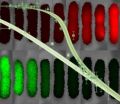(Press-News.org) Whether you're a Major League outfielder chasing down a hard-hit ball or a lesser mortal navigating a busy city sidewalk, it pays to keep a close watch on your surroundings when walking or running. Now, new research by UC San Francisco neuroscientists suggests that the body may get help in these fast-changing situations from a specialized brain circuit that causes visual system neurons to fire more strongly during locomotion.
There has been a great deal of research on changes among different brain states during sleep, but the new findings, reported in the March 13 issue of Cell, provide a compelling example of a change in state in the awake brain.
It has long been known that nerve cells in the visual system fire more strongly when we pay close attention to objects than when we view scenes more passively. But the new research, led by Yu Fu, PhD, a postdoctoral fellow in the UCSF lab of senior author Michael P. Stryker, PhD, the W.F. Ganong Professor of Physiology, breaks new ground, mapping out a visual system amplifier that is directly activated by walking or running.
Though this circuit has not yet been shown to exist in humans, Stryker is designing experiments to find out if it does. He said he would be surprised if his group did not identify a similar mechanism in people, since such systems have been found in fruit flies, and the mouse visual system has so far proved to be a good model of many aspects of human vision.
"The sense of touch only tells you about objects that are close, and the auditory system is generally not as sensitive as the visual system to the exact position of objects," he said. "It seems that it would be generally useful to have vision -- the sensory modality that tells you the most about things that are far away -- work better as you're moving through the world."
Stryker said that the neural system identified in the new work may have evolved to conserve energy, by allowing the brain to operate at less than peak efficiency in less demanding behavioral situations. "When you don't need your visual system to be in a high-gain state, your brain may use a lot less energy in responding," said Stryker. "A change in gain when you're moving is ideally what you'd like to see -- the neuron is doing the same thing that it's always doing, but it's talking louder to the rest of the brain."
In the new research, mice were allowed to walk or run freely on a Styrofoam ball suspended on an air cushion while the scientists used a technique known as two-photon imaging to monitor the activation of cells in the primary visual area of the brain, known as V1.
The researchers found that a subset of V1 neurons, those that contain a substance called vasoactive intestinal peptide (VIP), were robustly activated in a time-locked fashion purely by locomotion, even in darkness, while other V1 neurons remained largely silent.
The mice were presented with visual stimuli both while motionless and while moving, and measurements showed that walking could increase the response of V1 neurons by more than 30 percent. Moreover, V1 responses to these stimuli increased or declined in tandem with the activity of VIP neurons, and with the starting or stopping of walking by the mice.
To firmly establish that VIP neurons were responsible for these changes, the researchers used optogenetic techniques, inserting light-sensitive proteins exclusively into VIP neurons. Using light to stimulate just this population of cells, the team found that they could emulate the effects of locomotion -- when VIP cells were activated, V1 cells responded more strongly to stimuli, regardless of whether the animals were moving. Conversely, when the researchers specifically targeted and disabled VIP cells, locomotion-induced increases in the response of other V1 cells were abolished.
INFORMATION:
Postdoctoral fellows J. Sebastian Espinosa, PhD, Daniel P. Darcy, PhD (now a staff scientist at Dolby Labs), and Nengyin Sheng, PhD, as well as Roger P. Nicoll, MD, professor of cellular and molecular pharmacology, participated in the research. They were joined by Jason M. Tucciarone, an MD/PhD student at Stony Brook University, and Z. Josh Huang, PhD, of Cold Spring Harbor Laboratories. The work was supported by a grant from the National Institutes of Health.
UCSF is a leading university dedicated to promoting health worldwide through advanced biomedical research, graduate-level education in the life sciences and health professions, and excellence in patient care. It includes top-ranked graduate schools of dentistry, medicine, nursing and pharmacy, a graduate division with nationally renowned programs in basic biomedical, translational and population sciences, as well as a preeminent biomedical research enterprise and two top-ranked hospitals, UCSF Medical Center and UCSF Benioff Children's Hospital.
These boosts are made for walkin'
Study reveals that movement kicks visual system into higher gear
2014-03-13
ELSE PRESS RELEASES FROM THIS DATE:
Some racial disparities in childbirth more environmental than genetic
2014-03-13
A new study investigating racial disparities in birth outcomes shows that contrary to some theories Vitamin D is unlikely to play a role in differences in preterm birth and low birth weight between African-Americans and whites.
"For years there has been this hypothesis that African-Americans have worse birth outcomes because they have more melanin in their skin which reflects the sun and therefore lowers levels of Vitamin D," said study author Zaneta Thayer, PhD, assistant professor of anthropology at the University of Colorado Denver . "But in examining the relationship ...
New satellite movie shows massive Eastern US cool down
2014-03-13
VIDEO:
This animation of NOAA's GOES satellite data shows the progression of the major winter storm over the US Mid-Atlantic and northeastern US on March 12 and 13.
Click here for more information.
Three days of satellite imagery from NOAA's GOES-East satellite were compiled into an animation that showed the progression of the storm system that drastically changed temperatures in the Mid-Atlantic and Northeastern U.S. from spring-like warmth to the bitter cold of winter.
A ...
Study suggests potential association between soy formula and seizures in children with autism
2014-03-13
MADISON — A University of Wisconsin-Madison researcher has detected a higher rate of seizures among children with autism who were fed infant formula containing soy protein rather than milk protein.
The study found excess seizures among girls and in the total sample of 1,949 children. The soy-seizure link reached borderline significance among boys, who comprised 87 percent of the children described in the database under study.
Seizures — caused by uncontrolled electrical currents in the brain — occur in many neurological disorders including epilepsy, Alzheimer's disease, ...
A gene family that suppresses prostate cancer
2014-03-13
ITHACA, N.Y. – Cornell University researchers report they have discovered direct genetic evidence that a family of genes, called MicroRNA-34 (miR-34), are bona fide tumor suppressors.
The study is published in the journal Cell Reports, March 13.
Previous research at Cornell and elsewhere has shown that another gene, called p53, acts to positively regulate miR-34. Mutations of p53 have been implicated in half of all cancers. Interestingly, miR-34 is also frequently silenced by mechanisms other than p53 in many cancers, including those with p53 mutations.
The researchers ...
An equation to describe the competition between genes
2014-03-13
In biology, scientists typically conduct experiments first, and then develop mathematical or computer models afterward to show how the collected data fit with theory. In his work, Rob Phillips flips that practice on its head. The Caltech biophysicist tackles questions in cellular biology as a physicist would—by first formulating a model that can make predictions and then testing those predictions. Using this strategy, Phillips and his group have recently developed a mathematical model that accounts for the way genes compete with each other for the proteins that regulate ...
Study finds that social ties influence who wins certain Hollywood movie awards
2014-03-13
WASHINGTON, DC, March 13, 2014 — When it comes to Oscars and some other Hollywood movie awards, who your friends are affects whether you win, according to a new study.
"Sociological theory suggests that the process of 'making it' in any field depends not only on individual merit, but also on the kind of audience that makes the judgments," said co-author Paul D. Allison, a sociology professor at the University of Pennsylvania. "Specifically, our study found that peers are more likely to favor award candidates who are highly embedded in the field, whereas critics will not ...
Study proposes new ovarian cancer targets
2014-03-13
PROVIDENCE, R.I. [Brown University] — In the complex genomic and molecular conspiracy that gives rise to ovarian cancer, what if researchers have been missing a whole set of suspects because they've been hiding in plain sight? That's the argument made by Brown University biologists in a new paper that combines evidence from original research and prior studies to raise new suspicions about a set of proteins that assist in regulating gene expression.
Scientists need such new leads in their investigation of ovarian cancer, the most deadly reproductive cancer. Mortality has ...
UCLA study yields more accurate data on thousands of years of climate change
2014-03-13
Using a cutting-edge research technique, UCLA researchers have reconstructed the temperature history of a region that plays a major role in determining climate around the world.
The findings, published online Feb. 27 in the journal Nature Geoscience, will help inform scientists about the processes influencing global warming in the western tropical Pacific Ocean.
The study analyzes how much temperatures have increased in the region near Indonesia, and how ocean temperatures affect nearby tropical glaciers in Papua New Guinea and Borneo. Researchers also evaluated ...
Migration in China: Shifting slightly, but still going strong
2014-03-13
The brain drain of educated workers is still felt most severely in China's central and western provinces, since most knowledge-based industries are generally concentrated in its large coastal cities. However, low-educated migrant workers increasingly find jobs in their home provinces in the central and western regions because of changing economic and government policy. So says Ye Liu and his colleagues of The Chinese University of Hong Kong in Hong Kong and The University of Leeds in the United Kingdom, who carried out a systematic analysis of migration trends in China ...
Mount Sinai scientists discover how Marburg virus grows in cells
2014-03-13
New York, NY – A protein that normally protects cells from environmental stresses has been shown to interact Marburg virus VP24, allowing the deadly Marburg virus to live longer and replicate better, according to a cell culture study led by scientists at the Icahn School of Medicine at Mount Sinai. The investigators say that deciphering the molecular details of how Marburg virus and the host protein interact may help in developing inhibitors of the virus. Results from the study are published online March 13 in the peer-reviewed journal Cell Reports.
Infections with Marburg ...
LAST 30 PRESS RELEASES:
Making lighter work of calculating fluid and heat flow
Normalizing blood sugar can halve heart attack risk
Lowering blood sugar cuts heart attack risk in people with prediabetes
Study links genetic variants to risk of blinding eye disease in premature infants
Non-opioid ‘pain sponge’ therapy halts cartilage degeneration and relieves chronic pain
AI can pick up cultural values by mimicking how kids learn
China’s ecological redlines offer fast track to 30 x 30 global conservation goal
Invisible indoor threats: emerging household contaminants and their growing risks to human health
Adding antibody treatment to chemo boosts outcomes for children with rare cancer
Germline pathogenic variants among women without a history of breast cancer
Tanning beds triple melanoma risk, potentially causing broad DNA damage
Unique bond identified as key to viral infection speed
Indoor tanning makes youthful skin much older on a genetic level
Mouse model sheds new light on the causes and potential solutions to human GI problems linked to muscular dystrophy
The Journal of Nuclear Medicine ahead-of-print tip sheet: December 12, 2025
Smarter tools for peering into the microscopic world
Applications open for funding to conduct research in the Kinsey Institute archives
Global measure underestimates the severity of food insecurity
Child survivors of critical illness are missing out on timely follow up care
Risk-based vs annual breast cancer screening / the WISDOM randomized clinical trial
University of Toronto launches Electric Vehicle Innovation Ontario to accelerate advanced EV technologies and build Canada’s innovation advantage
Early relapse predicts poor outcomes in aggressive blood cancer
American College of Lifestyle Medicine applauds two CMS models aligned with lifestyle medicine practice and reimbursement
Clinical trial finds cannabis use not a barrier to quitting nicotine vaping
Supplemental nutrition assistance program policies and food insecurity
Switching immune cells to “night mode” could limit damage after a heart attack, study suggests
URI-based Global RIghts Project report spotlights continued troubling trends in worldwide inhumane treatment
Neutrophils are less aggressive at night, explaining why nighttime heart attacks cause less damage than daytime events
Menopausal hormone therapy may not pose breast cancer risk for women with BRCA mutations
Mobile health tool may improve quality of life for adolescent and young adult breast cancer survivors
[Press-News.org] These boosts are made for walkin'Study reveals that movement kicks visual system into higher gear



